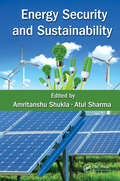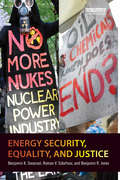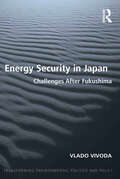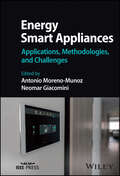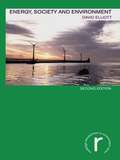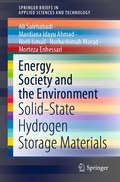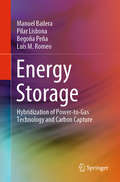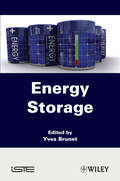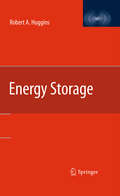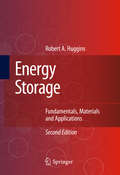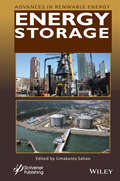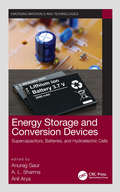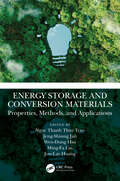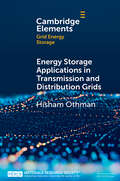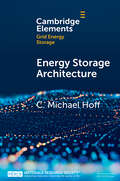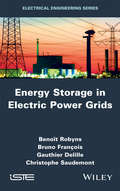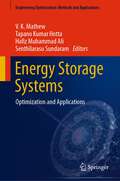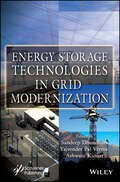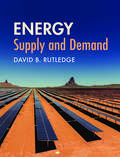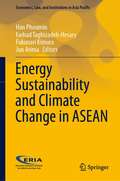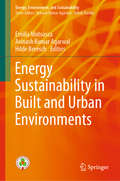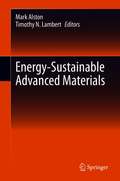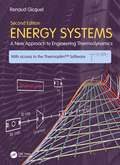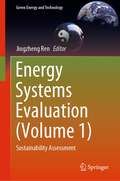- Table View
- List View
Energy Security and Sustainability
by Atul Sharma Amritanshu ShuklaThere has been ever increasing interest in understanding the various aspects of available resources and production, in terms of need and supply, conservation and environmental impacts and so on. From the current energy scenario, it is very clear that there are serious challenges related in achieving energy sustainability and security worldwide. The aim of this book is to present an overview of progress made towards energy sustainability addressing concerns regarding carbon emission and clean energy resources. Keeping this in mind, the book has chapters on all major energy sources which are being utilized at present, along with those having potential prospects for future.
Energy Security, Equality and Justice
by Benjamin K. Sovacool Roman V. Sidortsov Benjamin R. JonesThis book applies concepts from ethics, justice, and political philosophy to five sets of contemporary energy problems cutting across time, economics, politics, geography, and technology. In doing so, the authors derive two key energy justice principles from modern theories of distributive justice, procedural justice, and cosmopolitan justice. The prohibitive principle states that "energy systems must be designed and constructed in such a way that they do not unduly interfere with the ability of people to acquire those basic goods to which they are justly entitled." The affirmative principle states that "if any of the basic goods to which people are justly entitled can only be secured by means of energy services, then in that case there is also a derivative entitlement to the energy services." In laying out and employing these principles, the book details a long list of current energy injustices ranging from human rights abuses and energy-related civil conflict to energy poverty and pervasive and growing negative externalities. The book illustrates the significance of energy justice by combining the most up-to-date data on global energy security and climate change, including case studies and examples from the electricity supply, transport, and heating and cooking sectors, with appraisals based on centuries of thought about the meaning of justice in social decisions.
Energy Security in Japan: Challenges After Fukushima (Transforming Environmental Politics and Policy)
by Vlado VivodaFor a country already uneasy about energy security, the 2011 earthquake and tsunami, which caused a nuclear catastrophe at the Fukushima nuclear power plant, turned pre-existing Japanese concern about the availability of energy into outright anxiety. The subsequent closure of many nuclear reactors meant Japan needed to replace lost power quickly and so had no choice but to secure additional fossil fuels, undermining Japanese diversification policy and increasing global and regional competition for energy. This switch has been at a cost to the already weak Japanese economy whilst the increase in fossil fuel consumption has caused a significant increase in greenhouse gas emissions. In this book Vlado Vivoda examines the drastically changed environment following the disaster in order to analyse Japan’s energy security challenges and evaluate Tokyo’s energy policy options. Looking at how the disaster exacerbated Japan’s existing energy security challenges, Vivoda considers the best policy options for Japan to enhance national energy security in the future, exploring the main impediments to change and how they might be overcome.
Energy Smart Appliances: Applications, Methodologies, and Challenges
by Antonio Moreno-Munoz Neomar GiacominiEnergy Smart Appliances Enables designers and manufacturers to manage real-world energy performance and expectations by covering a range of potential scenarios and challenges Energy Smart Appliances provides utilities and appliance manufacturers, and designers with new approaches to better understand real-world performance, assess actual energy benefits, and tailor each technology to the needs of their customers. With contributions from a fully international group of experts, including heads of prestigious research organizations and leading universities, and innovation managers of the main appliance manufacturers, Energy Smart Appliances includes discussion on: Enabling technologies for energy smart appliances, covering IoT devices and technology and active energy efficiency measures in residential environments Smart home and appliances, answering questions like ‘Where are we heading in terms of the overall smart homes’ future?’ and ‘What’s the energy impact from smart home devices?’ Demand-side management and demand response, covering overall system/ appliances readiness and ideal energy management scenario to drive demand response Energy smart appliances’ best practices and success stories, including refrigerators, washers, dryers, and more With practical coverage of a wide range of potential scenarios and existing and future challenges, Energy Smart Appliances is an essential learning resource for electrical engineering professionals, equipment manufacturers, and designers, along with postgraduate electrical engineering students and researchers in related fields and programs of study.
Energy, Society and Environment (Routledge Introductions to Environment: Environment and Society Texts)
by David ElliottSociety's use of energy and technology is at heart of many of the most significant environmental problems of recent years, including problems of health, global warming and acid rain. Use of technology has been a major cause of environmental problems but new technology offers many solutions.Energy, Society and Environment is an introduction to energy and energy use, and the interactions between technology, society and the environment. The book is clearly structured to examine:* key environmental issues, and the harmful impacts of energy use* new technological solutions to environmental problems* implementation of possible solutions* implications for society in developing a sustainable approach to energy use.Social processes and strategic solutions to problems are located within a clear, technological context with topical case studies and informative diagrams illustrating key issues.Energy, Society and Environment examines the potential and limits of technical solutions to environmental problems and suggests the social, economic and political changes necessary to avoid serious environmental damage in the future.
Energy, Society and the Environment: Solid-State Hydrogen Storage Materials (SpringerBriefs in Applied Sciences and Technology)
by Ali Salehabadi Mardiana Idayu Ahmad Norli Ismail Norhashimah Morad Morteza EnhessariThis book provides a comprehensive and contemporary overview of advances in energy and energy storage technologies. Although the coverage is varied and diverse, the book also addresses unifying patterns and trends in order to enrich readers’ understanding of energy and energy storage systems, particularly hydrogen energy storage, including e.g. their morphology, porosity and material structure. Readers will also gain insights into the hydrogen storage performance landscape, based on data released by the US Department of Energy (DOE), providing a basis for understanding real-world applications. The book also discusses the superior hydrogen storage performance of solid-state materials and explores the physical and chemical properties that can potentially affect their performance.
Energy Storage: Hybridization of Power-to-Gas Technology and Carbon Capture (Springerbriefs In Energy Ser.)
by Manuel Bailera Pilar Lisbona Begoña Peña Luis M. RomeoThis book presents a detailed analysis of Power-to-Gas, a promising energy storage technology. It discusses the main mechanisms involved, and presents two Power-to-Gas and carbon capture hybridizations. The book begins by providing an introduction to energy storage technologies. It then reviews a number of Power-to-Gas projects now in progress, highlighting the current barriers to commercializing the technology. Moreover, the book presents two novel Power-to-Gas hybridizations, which improve the technology’s applicability in terms of efficiency, utilization of resources and profitability. Given its scope, the book will be of interest to graduate students, researchers and practitioners in the fields of engineering and energy.
Energy Storage
by Yves BrunetEnergy storage examines different applications such as electric power generation, transmission and distribution systems, pulsed systems, transportation, buildings and mobile applications. For each of these applications, proper energy storage technologies are foreseen, with their advantages, disadvantages and limits. As electricity cannot be stored cheaply in large quantities, energy has to be stored in another form (chemical, thermal, electromagnetic, mechanical) and then converted back into electric power and/or energy using conversion systems. Most of the storage technologies are examined: batteries, hydrogen, super capacitors, SMES, flywheels, CAES, thermal storage and hydraulic gravitational storage.
Energy Storage
by Robert HugginsThis is a comprehensive overview of energy storage concepts, methodologies and applications. Students will find chapters exploring the underlying energy storage fundamentals under various conditions, such as organic fuels, phase transitions and heat capacity, in addition to reversible chemical reactions. Important energy storage types such as mechanical, hydrogen and electromagnetic energy storage are discussed in a pedagogical language and structure accessible to students and researchers alike. Valuable coverage of various types of batteries are included, such as metal hydride / "nickel", lithium, lead-acid and primary batteries, in addition to a variety of current applications.
Energy Storage
by Robert A. HugginsEnergy Storage explains the underlying scientific and engineering fundamentals of all major energy storage methods. These include the storage of energy as heat, in phase transitions and reversible chemical reactions, and in organic fuels and hydrogen, as well as in mechanical, electrostatic and magnetic systems. Updated coverage of electrochemical storage systems considers exciting developments in materials and methods for applications such as rapid short-term storage in hybrid and intermittent energy generation systems, and battery optimization for increasingly prevalent EV and stop-start automotive technologies. This nuanced coverage of cutting-edge advances is unique in that it does not require prior knowledge of electrochemistry. Traditional and emerging battery systems are explained, including lithium, flow and liquid batteries. Energy Storage provides a comprehensive overview of the concepts, principles and practice of energy storage that is useful to both students and professionals.
Energy Storage (Advances In Renewable Energy Ser.)
by Umakanta SahooThe world’s energy landscape is very complex. Fossil fuels, especially because of hydraulic fracturing, are still a mainstay of global energy production, but renewable energy sources, such as wind, solar, and others, are increasing in importance for global energy sustainability. Experts and non-experts agree that the next game-changer in this area will be energy storage. Energy storage is crucial for continuous operation of power plants and can supplement basic power generation sources over a stand-alone system. It can enhance capacity and leads to greater security, including continuous electricity supply and other applications. A dependable energy storage system not only guarantees that the grid will not go down, but also increases efficacy and efficiency of any energy system. This groundbreaking new volume in this forward thinking series addresses all of these issues, laying out the latest advances and addressing the most serious current concerns in energy storage. Whether for the veteran engineer or the student, this latest volume in the series, “Advances in Renewable Energy,” is a must-have for any library.
Energy Storage and Conversion Devices: Supercapacitors, Batteries, and Hydroelectric Cells (Emerging Materials and Technologies)
by Anurag GaurThis book presents a state-of-the-art overview of the research and development in designing electrode and electrolyte materials for Li-ion batteries and supercapacitors. Further, green energy production via the water splitting approach by the hydroelectric cell is also explored. Features include: • Provides details on the latest trends in design and optimization of electrode and electrolyte materials with key focus on enhancement of energy storage and conversion device performance • Focuses on existing nanostructured electrodes and polymer electrolytes for device fabrication, as well as new promising research routes toward the development of new materials for improving device performance • Features a dedicated chapter that explores electricity generation by dissociating water through hydroelectric cells, which are a nontoxic and green source of energy production • Describes challenges and offers a vision for next-generation devices This book is beneficial for advanced students and professionals working in energy storage across the disciplines of physics, materials science, chemistry, and chemical engineering. It is also a valuable reference for manufacturers of electrode/electrolyte materials for energy storage devices and hydroelectric cells.
Energy Storage and Conversion Materials: Properties, Methods, and Applications
by Tran, Ngoc Thanh Thuy Jeng-Shiung Jan Wen-Dung Hsu Ming-Fa Lin Jow-Lay HuangThis book explores the fundamental properties of a wide range of energy storage and conversion materials, covering mainstream theoretical and experimental studies and their applications in green energy. It presents a thorough investigation of diverse physical, chemical, and material properties of rechargeable batteries, supercapacitors, solar cells, and fuel cells, covering the development of theoretical simulations, machine learning, high-resolution experimental measurements, and excellent device performance. Covers potential energy storage (rechargeable batteries and supercapacitors) and energy conversion (solar cells and fuel cells) materials Develops theoretical predictions and experimental observations under a unified quasi-particle framework Illustrates up-to-date calculation results and experimental measurements Describes successful synthesis, fabrication, and measurements, as well as potential applications and near-future challenges Promoting a deep understanding of basic science, application engineering, and commercial products, this work is appropriate for senior graduate students and researchers in materials, chemical, and energy engineering and related disciplines.
Energy Storage Applications in Transmission and Distribution Grids (Elements in Grid Energy Storage)
by Hisham OthmanThe application of energy storage within transmission and distribution grids as non-wire alternative solutions (NWS) is hindered by the lack of readily available analysis tools, standardized planning processes, and practical know-how. This Element provides a theoretical basis along with examples and real-world case studies to guide grid planners in the siting, sizing, and lifetime techno-economic evaluation of storage systems. Many applications are illustrated including feeder peak shaving, feeder reliability improvements, transmission reliability, transmission congestion relief, and renewable integration. Three case studies, based on the author's consulting experience, illustrate the versatility of the analysis methods and provide a guide to grid planners while tackling real world problems.
Energy Storage Architecture (Elements in Grid Energy Storage)
by C. Michael HoffEnergy storage systems (ESS) exist in a wide variety of sizes, shapes and technologies. An energy storage system's technology, i.e. the fundamental energy storage mechanism, naturally affects its important characteristics including cost, safety, performance, reliability, and longevity. However, while the underlying technology is important, a successful energy storage project relies on a thorough and thoughtful implementation of the technology to meet the project's goals. A successful implementation depends on how well the energy storage system is architected and assembled. The system's architecture can determine its performance and reliability, in concert with or even despite the technology it employs. It is possible for an energy storage system with a good storage technology to perform poorly when implemented with a suboptimal architecture, while other energy storage systems with mediocre storage technologies can perform well when implemented with superior architectures.
Energy Storage in Electric Power Grids
by Christophe Saudemont Benoît Robyns Gauthier Delille Bruno FrançoisThis book deals with the management and valuation of energy storage in electric power grids, highlighting the interest of storage systems in grid applications and developing management methodologies based on artificial intelligence tools. The authors highlight the importance of storing electrical energy, in the context of sustainable development, in "smart grids", and discuss multiple services that storing electrical energy can bring. Methodological tools are provided to build an energy management system storage following a generic approach. These tools are based on causal formalisms, artificial intelligence and explicit optimization techniques and are presented throughout the book in connection with concrete case studies.
Energy Storage Systems: Optimization and Applications (Engineering Optimization: Methods and Applications)
by Hafiz Muhammad Ali Tapano Kumar Hotta V. K. Mathew Senthilarasu SundaramThis book discusses generalized applications of energy storage systems using experimental, numerical, analytical, and optimization approaches. The book includes novel and hybrid optimization techniques developed for energy storage systems. It provides a range of applications of energy storage systems on a single platform. The book broadly covers—thermal management of electronic components in portable electronic devices; modeling and optimization aspects of energy storage systems; management of power generation systems involving renewable energy; testing, evaluation, and life cycle assessment of energy storage systems, etc. This book will serve as a reference resource for researchers and practitioners in academia and industry.
Energy Storage Technologies in Grid Modernization
by Sandeep Dhundhara Yajvender Pal Verma Ashwani KumarENERGY STORAGE TECHNOLOGIES IN GRID MODERNIZATION Written and edited by a team of experts, this exciting new volume discusses the various types of energy storage technologies, the applications of energy storage systems, their role in the real-time operation of power markets, and the operational issues of modern power systems, including renewable-based generating sources. The worldwide energy sector, specifically power generation, has undergone a huge transformation in recent years, and the focus is to make it sustainable, environmentally friendly, reliable, and highly efficient. As a result, a significant share of highly intermittent but clean renewable sources is being integrated into the power system using advanced technological components. The higher penetration level of renewable energy sources (RESs) has increased the active power generation share in the grid but reduced the total rotating system inertia. This high reduction in inertia brings new challenges and technical issues to the operators of modern power systems and impacts the stability and security of the grid. The stochasticity of these renewable sources also poses a big challenge to the efficient operation of the power system. Electrical energy storage systems help to manage such issues and challenges that occur due to the intermittent nature of RES and can play a big role in the smooth and reliable operation of the power system. The applications and opportunities to use storage on the grid are growing due to the improvements in energy storage technologies, and flexible regulatory frameworks. Technological developments have made it possible to use batteries and other Energy Storage Systems (ESSs) for managing the operation of the power system. This book aims to illustrate the potential of energy storage systems in different applications of the modern power system considering recent advances and research trends in storage technologies. These areas are going to play a very significant role in future smart grid operations. This book discusses the various types of energy storage technologies and promotes the applications of ESSs in the performance improvement of modern power systems. Whether for the veteran engineer, new hire, or student, it is a must-have for any library.
Energy: Supply and Demand
by David B. RutledgeFocusing on trends in energy supply and demand, this text provides students with a comprehensive account of the subject and an understanding of how to use data analysis and modeling to make future projections and study climate impacts. Developments in technology and policy are discussed in depth, including the role of coal, the fracking revolutions for oil and gas, the electricity grid, wind and solar power, battery storage, and biofuels. Trends in demand are also detailed, with analysis of industrial demands such as LEDs, air conditioning, heat pumps, and information technology, and the transportation demands of railroads, ships, and cars (including electric vehicles). The environmental impacts of the energy industry are considered throughout, and a full chapter is dedicated to climate change. Real-life case studies and examples add context, and over 400 full-color figures illustrate key concepts. Accompanied by a package of online resources including solutions, video examples, sample data, and PowerPoint slides, this is an ideal text for courses on energy and is accessible to a range of students from engineering and related disciplines.
Energy Sustainability and Climate Change in ASEAN (Economics, Law, and Institutions in Asia Pacific)
by Han Phoumin Farhad Taghizadeh-Hesary Fukunari Kimura Jun ArimaThis book provides several up-to-date empirical policy-oriented studies on assessing the impacts of climate change on various economic sectors and the role of renewable energy resources in mitigating pollution and climate change. It suggests various policy recommendations on how to increase the share of renewable energy resources in the energy baskets of the members of the Association of Southeast Asian Nations (ASEAN) and the rest of the world to ensure energy sustainability. As of 2020, most of the world’s energy investment still went to carbon-emitting sources, namely, fossil fuels. On the other hand, the Covid-19 pandemic and the economic Project Overview 20 March 2021 08:39 Page 6 of 9 downturns shrank the global energy demand, including fossil fuels, resulting in a sharp drop in their prices. Low fossil fuel prices are harmful to developing renewable energy projects, making solar, wind, and other renewable energy resources less competitive as sources of electricity. This is endangering the Paris agreement and the “Climate Action” goal of the United Nations. Given the high share of fossil fuels in the energy mix of the members of ASEAN, tremendous challenges must be faced for their energy transition in the post-Covid-19 world. The authors call for sound policy and applicable technologies to ensure sustainable energy availability, accessibility, and affordability to reach emission reduction targets.
Energy Sustainability in Built and Urban Environments (Energy, Environment, and Sustainability)
by Emilia Motoasca Avinash Kumar Agarwal Hilde BreeschThis book covers different aspects of energy sustainability in residential buildings and neighborhoods, starting from the construction and design aspects, and moving on to HVAC systems and lighting, and the applications, harvesting, use and storage of renewable energy. The volume focuses on smart and sustainable use of energy, discussing both the technological advancements and the economic, social and environmental impacts. Novel approaches to recycling of waste and materials in the context of residential buildings are also presented. This volume will be of interest to researchers and policy makers working in the fields of renewable energy, sustainable design and city planning.
Energy Sustainability in Built and Urban Environments (Energy, Environment, and Sustainability)
by Emilia Motoasca Avinash Kumar Agarwal Hilde BreeschThis book covers different aspects of energy sustainability in residential buildings and neighborhoods, starting from the construction and design aspects, and moving on to HVAC systems and lighting, and the applications, harvesting, use and storage of renewable energy. The volume focuses on smart and sustainable use of energy, discussing both the technological advancements and the economic, social and environmental impacts. Novel approaches to recycling of waste and materials in the context of residential buildings are also presented. This volume will be of interest to researchers and policy makers working in the fields of renewable energy, sustainable design and city planning.
Energy-Sustainable Advanced Materials
by Mark Alston Timothy N. LambertThis book highlights progress towards the capture, storage, and utilization of energy through the development of advanced materials and systems based on abundant elements, materials, and commodities. Energy is critical to human sustainability and a global-scale deployment of renewable energy systems will be required. Hence, the chapters integrate the fundamental aspects that enable the technical advancements in detail, along with an emphasis on the need for highly sustainable materials to enable real impact for humankind: To determine innovation of energy capture and storage through characterizations of materials in areas of electrical generation and electrical storage systems; To demonstrate better performance, economic and environmental advantages than the current state of the art; To define new chemistries and materials for innovations in energy density design through lower operational temperatures, improve safety, expanding operational voltage, battery durability lifetimes, and reduce system costs. Advances critical technical and commercial objectives for novel high energy density materials;Evaluates operational material models for optimizing energy capture that are integrated by configurations as a system; Illustrates utilization of material life cycle assessment for high energy outputs generators for sustainable materials.
Energy Systems: A New Approach to Engineering Thermodynamics
by Renaud GicquelConsidered as particularly difficult by generations of students and engineers, thermodynamics applied to energy systems can now be taught with an original instruction method. Energy Systems applies a completely different approach to the calculation, application and theory of multiple energy conversion technologies. It aims to create the reader’s foundation for understanding and applying the design principles to all kinds of energy cycles, including renewable energy. Proven to be simpler and more reflective than existing methods, it deals with energy system modeling, instead of the thermodynamic foundations, as the primary objective. Although its style is drastically different from other textbooks, no concession is made to coverage: with encouraging pace, the complete range from basic thermodynamics to the most advanced energy systems is addressed. The accompanying Thermoptim™ portal (http://thermoptim.org) presents the software and manuals (in English and French) to solve over 200 examples, and programming and design tools for exercises of all levels of complexity. The portal explains to the user how to build appropriate models to bridge the technological reality with the theoretical basis of energy engineering. Offering quick overviews through e-learning modules moreover, the portal is user-friendly and enables users to quickly improve their proficiency. Students can freely download the Thermoptim modeling software demo version (available in seven languages), and extended options are available to lecturers. A professional edition is also available and has been adopted by many companies and research institutes worldwide (www.s4e2.com). This volume is intended as a textbook for courses in applied thermodynamics, energy systems, energy conversion and thermal engineering taken by senior undergraduate and graduate-level students in mechanical, energy, chemical and petroleum engineering. Students should already have taken a first-year course in thermodynamics. The refreshing approach and exceptionally rich coverage make it a great reference tool for researchers and professionals as well.
Energy Systems Evaluation: Sustainability Assessment (Green Energy and Technology)
by Jingzheng RenThis book presents various methods for sustainability assessment of energy systems, under various different conditions and scenarios. It answers the questions of how to measure the sustainability of energy systems by adopting appropriate metrics and methods. This book provides readers with a comprehensive view of the frontiers of sustainability assessment methods for energy system analysis. It presents various methodologies, allowing readers to understand: the complete metrics for sustainability assessment; life cycle thinking for sustainability assessment of energy systems; and the advanced sustainability assessment methods for energy systems. This book is of interest to researchers, engineers, decision makers, and postgraduate students within the field of energy systems, sustainability, and decision analysis.
